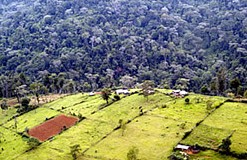
Sharing water resources between two neighboring countries can be a difficult challenge at any time. Add in fast-growing urban and rural human populations, increasing acreage devoted to agriculture, and the desire to preserve one of the world's most treasured natural wonders, and you'll have some idea of the issues that the Transboundary Water for Biodiversity and Human Health in the Mara River Basin (TWB-MRB) Project has faced in Kenya and Tanzania.
The Mara River, some 395 kilometers long (245 miles), begins its flow southward in southern Kenya. It passes through Kenya's Masai Mara National Reserve, and then into the adjoining Serengeti National Park, in Tanzania. Those two parks are home to some of the world's highest concentrations of animal herds. The annual migrations of more than one and a half million wildebeest, zebras, and gazelles are a major tourist attraction—and a substantial source of income for the two countries.
The water needs for humans and ecosystems are diverse across the Mara River Basin. The northern-most section of the basin is the forested Mau Escarpment, in Kenya. The Rift Valley area is the source of numerous springs, streams, and the Amala and Nyangores, the two rivers that converge and form the Mara River. Ongoing forest clearing, however, threatens the water supplies for small and medium-sized farms in that region, as well as other, downstream water users.
The Mara River passes through grasslands where Masai people pasture their livestock. This area includes many small- and large-scale farms, some of which are irrigated using Mara River water. Further to the south are the adjacent parks in Kenya and Tanzania. There, the river flow is vital to maintaining the biodiversity of those protected areas. The last area the river traverses before discharging into Lake Victoria is the flood plains in Tanzania. High human and livestock population densities and subsistence agriculture characterize this section.
To help meet these varied water demands across the Mara River Basin, in 2005 the U.S. Agency for International Development (USAID) provided funding to launch the TWB-MRB project. The project is now being implemented by the Global Water for Sustainability (GLOWS) program, a consortium that is led by Florida International University. On the TWB-MRB project, GLOWS partners with CARE, World Vision International, and the World Wildlife Fund (WWF).
The TWB-MRB project began with initial studies of the quantity and quality of the water in the Mara River Basin. The project also started working with national, regional, and local government units and other organizations on the difficult task of planning for the multiple, varied water needs throughout the basin. In the Masai Mara National Reserve, project staff assisted tourist hotels and lodges to improve their waste-water disposal practices.
The project has helped local communities to develop new water services, refurbish nonfunctioning water systems, and improve sanitation services. There has also been support for setting up water user associations and village savings and loan groups, emphasizing the participation and empowerment of women and the long-term sustainability of the new organizations. Forming those local groups, as well as entities that involve participation from across the river basin, has built the capacity of grass-roots civil society organizations to shape decisions in both Kenya and Tanzania related to the Mara River Basin.
More recently, the project completed an environmental flows assessment (EFA) for the river basin. The EFA quantified the water needs through the basin and recommended steps to ensure that those competing demands are satisfied. The assessment was officially adopted by the Lake Victoria Basin Commission of the East African Community. That high-level endorsement will be key to the effective, long-term cross-border management of the basin's water resources in both countries.
Underlying much of the project's success has been an ongoing emphasis on developing solid scientific information and then applying that new knowledge in guiding realistic policy and undertaking effective local and regional activities.
In some water projects, says Maria Donoso, the GLOWS program director, "you can see pure research studies that don't get translated into policy—and vice versa. They're not successful because they don't connect with each other."
"With the Mara River Basin," Maria affirms, "we've been able to translate the environmental flows assessment into a change of direction and into an increased awareness at the policy level of the importance of the river basin."
GLOWS promotes the integrated management of freshwater systems. In addition to the work in the Mara River Basin, GLOWS promotes the integrated management of freshwater systems in the Wami-Ruvu Basin of Tanzania, the Pastaza River Basin of Ecuador and Peru, and the Wakal River Basin of India's state of Rajasthan.







Comment
Make a general inquiry or suggest an improvement.